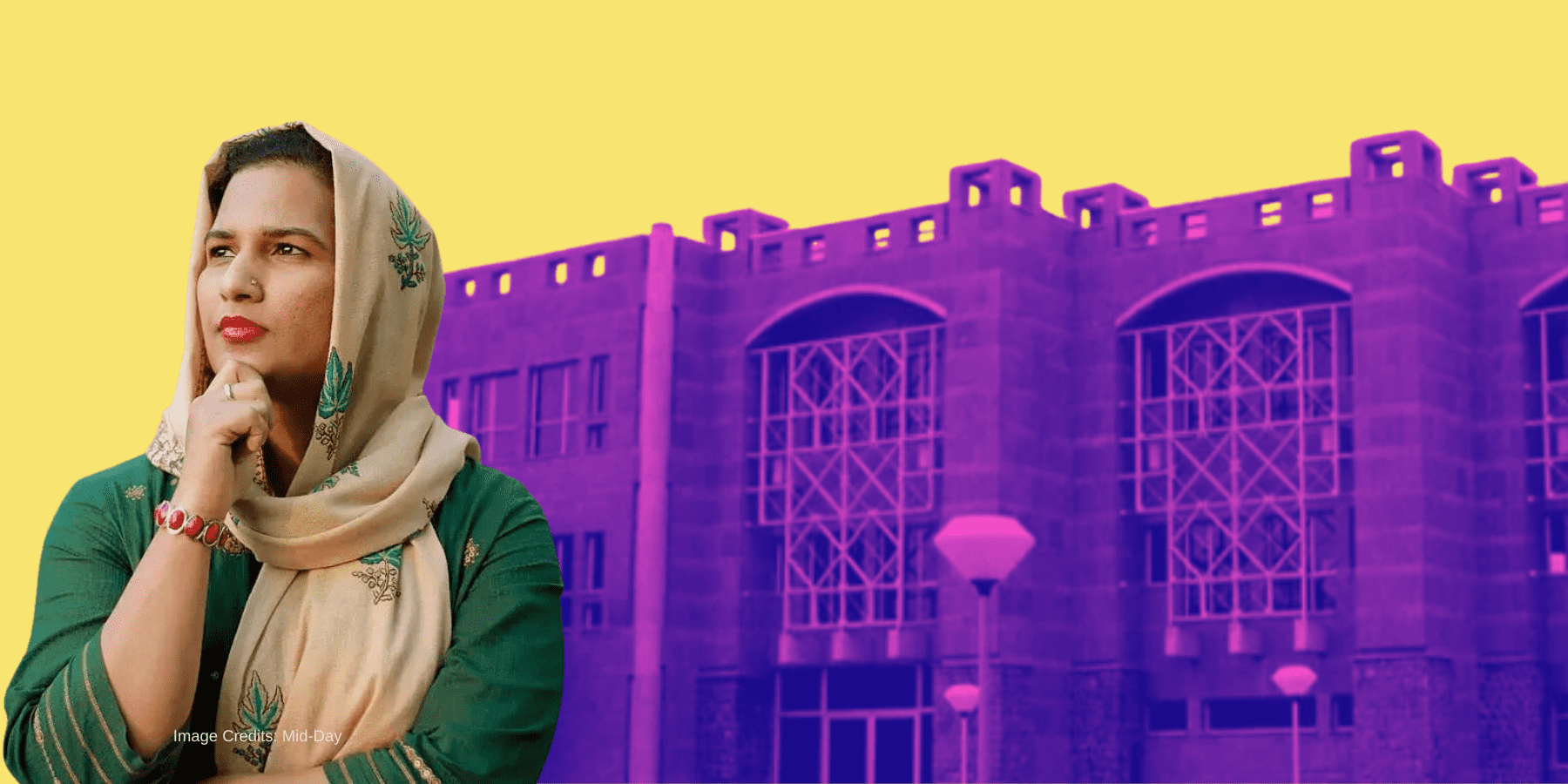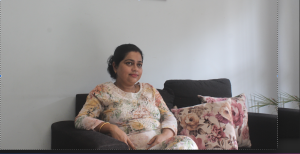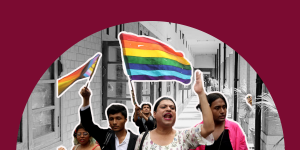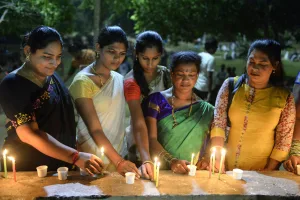‘Queer Affirmative Medical Education Should Begin At School, Not College’

Medical education has remained largely binary, focusing on male/female bodies, heterosexuality and Cis-gendered lives. There are nascent efforts now to make medical education – and the public health system – queer affirmative. These steps include the National Medical Commission’s move to change its medical curriculum to reflect the lived realities of LGBTQIA+ folks, the historic NALSA judgement that gave legal status to trans and other non-binary identities making them legal beneficiaries of social welfare measures, the Madras Court High Court’ s ban on surgeries on intersex children, and the several government welfare schemes covering trans persons’ health care needs. But are these responsive enough to queer needs?
In an interview with Behanbox, Aqsa Shaikh, associate professor of Community Medicine at Hamdard Institute of Medical Sciences and Research (HIMSR), Jamia Hamdard and the director of the Human Solidarity Foundation, a Delhi-based NGO that runs a charitable clinic and undertakes hunger relief operations, says the journey of a queer-affirmative healthcare professional should start not in medical colleges, but in the early learning years in school. She also talks about the intersectional challenges of healthcare for trans persons with disabilities and the faultlines in our public and private health systems.
How can we make India’s public health system more queer affirmative?
Public health in India is largely in the government domain – whether it’s the central government, state governments or the local municipal bodies. They regulate public health through national health programmes, health budget, public health infrastructure, human resource, medical teaching and curriculum, provision of services, etc. India has always had a welfare state approach to healthcare, emphasising equity at both the individual and community levels. This approach takes into account numerous socio-economic factors and health indicators, including challenging geographical locations and reproductive health statistics, among others. As a result, our public health system strives to maintain a strong sense of equity in its service delivery.
But when it comes to the LGBTQIA+ population, they were never recognised by the State as legitimate marginalised groups. Since colonial times and even after Independence, queer people have been categorised as criminals or mentally ill people, which is why they have never really been considered the beneficiaries of the reforms in public health interventions. This started to change in the 21st century around the time the NALSA judgement came into effect. It recognised transgender, hijra, and kinnar identities and gave them fundamental rights, the right to determine their gender, recognised their marginalisation related to healthcare, provided them a legal status and, in turn, transformed them into legal beneficiaries of India’s social welfare measures like education, employment and health services. This was the first time queer people started to arrive in the imagination of public health.
When it comes to intersex people, our country’s commitment towards them has more to do with international obligations. The UN Convention on the Rights of Persons with Disabilities (CRPD) of which India is a signatory, advises against sex mutilating surgeries on children and adolescents without their consent and talks of how this practice must be stopped. This is one domain where queer identity has been taken into consideration. Subsequently, the Madras High Court’s ban on sex change surgery for intersex children is also a significant moment when it comes to queer rights.
For the longest time, when it came to the LGBTQIA+ population, the State has only been interested in decriminalising them, but not in looking at them as people who have been marginalised, or as people who may need affirmative actions in public health. In fact, it was only during the recent marriage equality hearings that the constitution bench proposed social welfare measures for the LGBTQIA+ communities because they are socially marginalised in terms of inheritance, health insurance, and other benefits.
Now there is significant recognition of these identities, especially when it comes to the T component of LGBTQIA+. In terms of healthcare, the national health policy mentions trans people, and during COVID the centre made efforts to ensure that they face no discrimination in vaccination. But measures for LGB populations are still missing.
We also see a significant amount of financial allocation being provided for issues affecting trans people not only in terms of policy measures but also in terms of welfare schemes, like the Transgender Persons (Protection of Rights) Act 2019, Smile scheme, and Ayushman Bharat TG plus card. While these are early signs of the intentions of the government in making policies that safeguard the rights of transgender people, there is more to be done: [allocation of] human resources and infrastructure, service upgradation, monitoring and evaluation, and auditing of policies and schemes to see if these measures are really affirmative.
To what extent is contemporary medical education queer affirmative?
Fifty years ago, the American Psychology Association took a significant step by declaring that queerness is not to be considered a disease, leading to the discontinuation of conversion therapy. It took time for that to be translated into changes in terms of the Diagnostic and Statistical Manual of Mental Disorders (DSM) criteria used by the World Health Organisation (WHO), into changes in the International Classification of Diseases (ICD) criteria, and to come down to places in India where psychiatry was still in developmental stages 50 years ago. It’s only recently in 2018, just months before the decriminalisation of Section 377, that the Indian Psychiatric Society came out with a policy statement that sexual orientation and gender identity are not pathologies that need treatment, and that conversion therapy should be banned.
Our healthcare system and medical education has now moved from pathologising queer folks (as bodies with diseases and mental illness that need traumatic conversion therapy, or surgically ‘correcting’ intersex children on demand of their parents or surgeons) to a stage where they have be de-pathologised by saying that it is no longer a disease, or even a crime, to be queer. At this current stage, we are looking at gender-affirming procedures, court orders that say intersex surgeries should not be done unnecessarily, the National Medical Commission (NMC) banning conversion therapy, and curricular reform. There has been a great shift and progress in the last couple of decades. I am optimistic that this change will continue.
There is also a growing recognition within the medical fraternity that it needs to do something about this. There is a perception that we need to understand more about queerness.
I have been part of Sangath, a not-for-profit organisation focused on community healthcare among marginalised communities, where we started the TransCare Med-Ed project to find ways to create trans affirmative curriculum. Our other ongoing project is based on creating queer affirmative curriculum that encompasses a larger LGBTQIA+ spectrum. Another similar project is Queer Campus Ambassadors, where medical students and medical teachers are coming together to create small queer clubs in their medical colleges to increase LGBTQIA+ inclusivity across health and allied professional colleges.
Thus, I see that more and more universities and campuses are willing to talk about this, and are making space for queer affirmativeness.
We are also seeing more administrative commitment as well as a willingness among medical educators to change the curriculum, and even invite queer folks to speak on campuses. Not only this, more and more queer persons are becoming healthcare providers. I feel this is the ultimate test of a progressive system: where marginalised populations not just get affirmative services but they also rise up to the level where they provide those services, hold decision-making power, and start changing the system from within. In India, although a small number but a significant achievement, we have 25 trans doctors and 100+ queer doctors, apart from those already in the nursing services, paramedical staff, and dentistry. I am hopeful that in the next few years, there will be more legal interventions to safeguard queer rights with robust implementation.
Do you think these changes are real or are they just tokenistic?
It is true that legal provisions have led to the availability of healthcare measures for queer and trans folks. These legal provisions have nudged and forced the government to provide healthcare measures for this community. Otherwise it would not have happened. But while we give credit to the courts, we must also give credit to the petitioners who come from the community, and who, among the various options available to them, chose the legal option.
Most of these petitions on queer rights have emerged from a healthcare need. When in 2001, Naz Foundation, a Delhi-based NGO that works on HIV-AIDS issues, filed a Public Interest Litigation (PIL) in the Delhi High Court challenging the constitutionality of Section 377 and calling for the legalisation of homosexuality, it did that so that they could provide HIV prevention services to Men having Sex with Men (MSM) who were criminalised under the act. Their healthcare discrimination led to the legal fight for queer rights, and subsequently led to the provision of healthcare for queer people.
In spite of its lacunae, when the NALSA Judgement came out, it was a very progressive judgement. But when the government came out with the Trans Bill in 2018, the first couple of versions were horrendous. The outrage against it was obvious, because it was not in the spirit of the NALSA judgement which laid down the right to self-determination of one’s gender identity. While the Bill was amended later by doing away with the criminalisation of begging and the establishment of a district screening committee to process applications for issuance of transgender persons, the Act in its current form is still a poor version of what the community had demanded. For instance, the Act fails to incorporate the right of transgender people to declare their self-perceived gender identity without undergoing sex reassignment surgery, and [the demand for] horizontal reservations in jobs and educational institutions.
It would be fair to say that the government’s approach is more in line with charity: ‘We will provide you a one-time grant COVID grant, Garima Grehs or shelter homes for trans people, health insurance through the Ayushman Bharat TG plus card, all the while our legal rights continue to be denied. A lot of projection about trans welfare measures but implementation is severely lacking.
For example, to benefit from social welfare schemes, it is important that the beneficiary population is identified. While the government launched a transgender portal where trans people will be issued ID cards, only a handful of them have been able to get an ID card. I don’t find the honesty or sincerity from the central and state government in really providing healthcare services to transgender population, and we are not even talking about the LGB right now because the government does not talk about them.
As a teacher, what are the challenges of imparting queer-affirmative medical education?
When medical students enter medical colleges at 18, their thoughts, beliefs, values, biases, misconceptions, etc are quite fixed. It is too late to try to change that even in a first-year medical college student. These students have spent at least 10-15 years in schools in an environment where gender notions were binary, and there was only a ‘certain way’ that was considered to be ‘normal’. For them now to unlearn all of that, is difficult. If we really want to make queer affirmative doctors, then we need to have queer affirmative school students. The journey of queering medical education does not start in the first year of medical college, it starts on the first day of school. It starts even further back, at homes when the child is taught the notion of gender within their families, relatives, neighbourhoods etc. This needs a paradigm shift and this shift will not be a smooth process and there will be resistance. For instance, when the NCERT commissioned a teacher-training manual on transgender inclusive education, which has now been removed, it was met with very organised resistance from none other than the National Commission for The Protection of Child Rights (NCPCR), a body that is supposed to protect child rights.
For any change to happen, we need teachers, parents, and school students to feel that there is a need for a paradigm shift – recognising diversity in children, not just in terms of gender and sexual orientation, but also in terms of neurodivergence, religion, and caste. There is a need for social reform, like how we had a few hundred years back when Jyotiba Phule, Savitribai and Fatima Sheikh spoke about reforms in education by removing it from the clutches of the dominant castes and making it available to everyone. We need to ask how we can make education available to everyone with multiple intersections – whether it is religion, caste, gender identity, sexual orientation, neurodiversity, etc.
Would you say that medical education around queer and trans identities is strictly limited to a medical model — to ideas of transition, and gender affirming surgeries? How limiting is this approach and what should be the focus of medical education on queer lives beyond that?
The medical system currently is at a very curative and therapeutic stage that only looks at ‘diseased’ people. Health is a much broader category – you look at social health, emotional health, preventing disease at the outset, looking at health equity and health rights. When it comes to the queer community, the medical world has historically exhibited a fascination with this community, often treating them as if they were exotic beings with biological or psychological variations that were beyond medical understanding. Therefore, the urge to do something and change them came in the form of conversion therapy. It’s only recently that we have started accepting it as a normal variation of human existence. Unfortunately people in the medical system are hardwired to approach things therapeutically and curatively.
In the current landscape, queer individuals often encounter the medical system in specific contexts, such as seeking treatment for HIV, mental health support, or undergoing gender affirming surgery. Additionally, intersex individuals may be subjected to procedures aimed at “normalising” their sex. As a result, medical students and doctors perceive queer individuals solely through the lens of these medical interventions, in terms of bodies and minds that need ‘change’. This also limits their understanding of the diverse experiences and needs within the queer community.
The Transgender Persons (Protection of Rights) Act, 2019 outlines the process for gender transition, specifically focusing on surgical procedures for transitioning from male to female. Essentially, the law states that the government will recognise someone as a woman only if they have specific anatomical features or the lack of them. This legal framework reinforces the notion that being transgender is primarily a medical condition, which leads to feelings of dysphoria (dysphoria or gender dysphoria is a feeling of discomfort or distress that might occur in people whose gender identity differs from their sex assigned at birth or sex-related categories) among trans individuals.
This emphasis on medical criteria for recognition has the potential to shape the mindset of healthcare providers. They may start assuming that all transgender people desire transition-related services or that their ultimate goal is to fit into a binary understanding of being a ‘complete’ man or woman. However, this narrow perspective fails to acknowledge the diverse experiences and identities within the transgender community.
In this model, there is no space for trans people who are non-binary, genderqueer, gender fluid, bisexual and intersex people who don’t want to be binary. It’s crucial to avoid getting caught up in the narrative of “pre-transition” and “post-transition,” as well as the glorification of “before” and “after” pictures of transgender individuals. In all our approaches, we talk of ‘shared decision making’ where trans people have enough information and choice to make that decision regarding how they want to express themselves, how they want their bodies to be.
The second thing that we have been trying to do to de-medicalise trans narratives is by talking of things beyond the three domains of transition, infection and mental illness. What if a trans person comes to you with anaemia – a simple deficiency of haemoglobin, how would you diagnose them? Unfortunately, as a doctor we know the normal cut off for haemoglobin for men and women, but we don’t know what that cut off is for transgender people. Doctors not knowing this simple yet important thing are failing transgender patients. Why are we not talking about that? Is anaemia any less important than depression or HIV?
Trans-affirmative medical knowledge is important, because when a transgender person comes to me for a surgery related to their abdomen, it makes a difference because medical intervention for men and women is different because their anatomy is different. So if I’m doing surgery on a woman’s body then I’m trained to expect a uterus in her body, but then I’m forgetting that it is a trans woman and there won’t be a uterus in that space. As a surgeon, even though I’m doing a simple surgery like removal of the appendix, this makes a difference. Why are we not talking about that?
We know that drugs act differently on men and women, and on people of different ethnicities as well. But we don’t study how drugs will affect transgender or queer bodies differently. Somewhere we are trying to tell the medical, researcher and pharma community to shift the conversation away from the genitalia, brain and the viruses to a global and holistic aspect of health. This should be done universally, right from the drugs and vaccines we take, surgical and medical procedures we undergo, and even policy systems. For instance, how do you write the gender of a person on a medical record – what name, pronouns and gender do you write?
We must shift the conversation away from gender transition surgeries to something that every transgender person needs, that is transgender affirmative healthcare.
How accessible is our healthcare system, public and private, for queer people with disabilities?
When we look at the movement for the rights of the queer and disabled community, [we see that] both have a common struggle – of being looked at from a very biological and medical lens, instead of a socal, political and legal lens.
The struggle for the rights of healthcare inclusion of disabled people started much earlier. The queer community has followed in the footsteps of the disability movement when it comes to legal and healthcare rights. In fact, we proposed a disability inclusive medical curriculum, before we introduced a transgender inclusive one. Even the formalisation of disability competencies in the curriculum happened much before the queer competencies were added.
When we speak about queer communities vs non queer communities, we say that every person cannot be queer, some of them will be cis-heterosexual right from their birth to their death. But all of us face some form of disability in our lives. For instance, we are all disabled at birth, because we cannot walk. We need assistance and people to carry us from one place to another. Baby trolleys are often compared to wheelchairs, why is there so much stigma to wheelchairs but not to strollers? Similarly, when we start ageing, we may lose our vision, hearing, have locomotor disabilities, dementia, etc. Therefore, you become a disabled person.
A very important aspect in all this is empathy. It is easier to develop empathy towards a disabled person than towards a queer person. If you have empathy as a healthcare provider, then you can make certain provisions in the healthcare system for them. Infact, most of the people who come to hospitals have some form of functional disability: people in extreme pain, people unable to walk so you come on a stretcher or a wheelchair. So a hospital has to be disabled friendly, at least for some forms of disability.
When a queer disabled person goes to a healthcare facility, they face more discrimination as a queer person than as a disabled person. Because disability is more socially accepted as compared to queer identities. We must also look at what happens when different intersections are also at play: for instance, queer identity, religion, caste, ethnicity, disability etc., which makes an individual’s experience unique.
We can’t only think about locomotor, visual and auditory disability, we have to talk about neurodiversity like intellectual disability, social models of disability like acid attack survivors who are also disabled, and psychological aspects of disability like people with schizophrenia, who are equally disabled too.
More than looking at healthcare provisions in terms of infrastructure and services, there are more critical questions that must be asked when it comes to queer disabled persons: How much free choice really do queer disabled folks have? How much decision making power do they have in taking healthcare decisions? Are queer disabled people included in research, and is it inclusive of their needs? Lastly, at a policy level, how many queer disabled people can pursue medicine? We see a strong opposition to disabled doctors pursuing medicine. Everytime a blind person or a wheelchair user wants to pursue medicine or surgery, there is a court case that they have to fight in order to practise medicine.
When we talk about queer and disabled folks’ interaction with the healthcare system, we must also start thinking in terms of medical education, in terms of research, in terms of them being in administrative positions. Only when all of this happens, can true inclusion of queer disabled people happen in the system.
We believe everyone deserves equal access to accurate news. Support from our readers enables us to keep our journalism open and free for everyone, all over the world.




